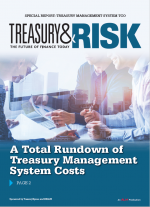
For many corporate managers, the Second Avenue Subway project in New York City serves as a chilling object lesson on the risks of budget and schedule overruns in major capital investments, including software implementations. Planned in 1968 and initially scheduled for completion in 1980, the city's newest subway line was hammered by out-of-control costs, ceaseless delays, political wrangling, and a staggering collection of related obstacles. The first phase did not open until January 2017, and work on the rest of the line continues today. Besides coming in 37 years late, the project has so far cost $4.5 billion, about $700 million over budget, according to Freakonomics Radio host Stephen J. Dubner.
Although treasury management system implementations are unlikely to go as horribly awry as the Second Avenue Subway, these projects carry their own risks and costs, and there are numerous ways they can go wrong. Many of the pitfalls stem from errors in cost estimates during project planning. "The cost of implementation is frequently underestimated, with components of operating costs often the most overlooked," notes Ed Page, managing director, technology consulting, for Protiviti.
That's a major problem because total cost of ownership (TCO) calculations "are critical to determine direct and indirect costs associated with running a treasury management system," asserts Sankar Krishnan, Capgemini executive vice president, banking and capital markets. "By getting the TCO wrong, we run the risk of making the wrong decisions."
Niklas Bergentoft, a risk and financial advisory principal in treasury at Deloitte & Touche LLP, concurs, stressing that it is "prudent to look at the total benefits a treasury management system and broader treasury transformation can offer, offsetting these by the total cost of system ownership." Those measures and calculations can be used to build a business case, typically underpinned by a return on investment (ROI) projection.
Unfortunately, the costs—the "I" in "ROI"—can be extremely tricky to calculate. These difficulties typically have less to do with technology than with people and process missteps. In a recent podcast, Dubner held up the Second Avenue Subway debacle as an illustration of how a project can be undermined by common human errors, including the planning fallacy (tendency to underestimate project timelines), an optimism bias, and the difficulty project planners have estimating the difficulty of executing projects that involve multiple stakeholders ("coordination neglect").
Similar human failings can plague software investments, including treasury management systems. One way of counteracting these biases is by conducting a thorough TCO evaluation. Complete and accurate TCO calculations do not require a Ph.D. They do, however, require an understanding of what TCO is, how it should be applied to quickly evolving treasury technology, and what risks to consider when conducting TCO calculations.
Treasury Technology and Personality Attributes
It also helps to understand organizational psychology, including the way in which the rest of the enterprise tends to view the treasury function's personality attributes.
Treasury professionals need to "fight for every single dollar in their budget," observes TreasuryXpress vice president, U.S., and chief marketing officer Tracy Kantrowitz. This is the case, Kantrowitz says, because treasury professionals are often seen as "the financial protectors of the system and not the spenders, so they are typically not well-funded as a department. This means that treasury teams are relatively creative and resourceful, and have managed to do their job using the tools available to them—such as Excel. When you have done a great job using something low-cost like spreadsheets, it is often difficult to prove that you can do an even better job for your organization using a treasury management system."
When existing operational practices within treasury are viewed as "good enough" by the rest of the organization, Kantrowitz says, the onus is on treasury teams "to show that the investment will bring greater financial opportunity to their organizations."
Making this case requires an understanding of how treasury management systems are evolving. These platforms have notched significant strides since the advent of cloud technology, although their core purpose remains unchanged: consolidating many different forms of data to deliver a consistent view of corporate cash and investments. This single source of truth is achieved by automating cash management and forecasting, payments, investment management, and related processes.
"The treasury technology landscape is changing rapidly," Bergentoft emphasizes. Driven by the integration of advanced technologies, these changes are having a positive effect from a purchaser's perspective: The technology is getting less expensive.
"With advancements in digital cloud technology, the trend is to build lean and nimble code with unlimited scalability," Kantrowitz explains. "If the solution is more economic for the vendor to develop, maintain, and advance, then those cost savings should be able to be passed on along to the clients."
Robotic process automation (RPA), artificial intelligence (AI), distributed ledger, optical character recognition (OCR), and other technological advancements driving these cost savings are helping some treasury functions begin to reinvent how they work. "It is widely believed that the future of treasury management is converging to a hybrid model of humans and bots working in close synchrony to achieve the objectives of treasury management," Krishnan reports, "which is mainly to optimize liquidity and make smart financial decisions involving liquid assets."
Disruption from—and integration of—machine learning, the cloud, open application programming interfaces (APIs), and other advanced technologies affects treasury management platforms, both through the capabilities the treasury systems offer and the underlying technologies that support them, notes Protiviti's Page. He points out that "emerging real-time payment solutions give rise to the notion of real-time treasury. Combined, these changes enable deeper integration with supply chains, faster collection cycles, reduced fraud, process automation, and improved decision-making."
While advanced technology is changing how financial transactions are recorded and verified, Grant Thornton LLP's Allison Flexer Hughes stresses, treasury management systems remain the treasury function's go-to information source more because of their core functionality than because of add-ons or cutting-edge enhancements. "The core treasury management system solution," says Hughes, a financial management experienced manager within Grant Thornton's business consulting practice, "remains the key driver of obtaining insight into liquidity positions, cash management, forecasts, and currency exposures—and ultimately provides the enterprise benefits the business is pursuing."
Reaping those benefits requires a comprehensive understanding of a treasury management system's total cost.
The Tao of TCO
The purpose of the TCO calculation is to project the cost of procuring, implementing, and operating a treasury management system. TCO, Page says, "provides a more effective basis for evaluating the benefits derived from that system over its lifetime, often expressed in terms of ROI or payback period." By calculating TCO and using it to project the ROI of a new treasury management system, "the treasury department ensures that the investment and any ensuing running costs strengthen the overall performance and security of the company and are therefore justified," explains Martin Bellin, CEO of BELLIN, a company that provides treasury management systems and other technology and services for corporate banking and treasury.
When it comes to conducting TCO calculations, Deloitte's Bergentoft stresses that the correct formula varies by organization. "Both the business case and the TCO need to be framed in the context of how the organization views business cases for investments," he suggests. "Most organizations I work with have general guidelines for making TCO calculations within the project management office, IT, and capital allocations functions." Many treasury teams choose to enlist vendors and/or external consultants for assistance with TCO calculations.
At the highest level, the primary components of the TCO calculation must include the costs of software and/or hardware (if needed); resources to install and configure the system, as well as to connect it with other solutions in the treasury technology infrastructure; training for treasury staff; and ongoing maintenance and support costs (including upgrades) of the system. From there, cost and benefit calculations can be relatively straightforward (e.g., a comparison of competing solutions' bank-fee–analysis capabilities) or get as detailed and complex as the project team desires (e.g., liquidity utilization comparisons or assessing the value of fraud mitigation).
Project teams may also need to calculate the opportunity cost associated with their current lack of some of the expected benefits of a new treasury management system, such as a failure to generate adequate returns on excess cash due to limited cash visibility. "It is important to understand the initial economic costs, but also the opportunity cost of inaction and [of] not pursuing a treasury management system [investment]," Hughes says. "Many organizations will not achieve their strategic goals without the insights into capital and the resulting forecasting information that a [treasury management system] provides."
This relationship helps explain why treasury consultants and treasury management vendors emphasize the need to compare TCO calculations with projected returns, and to consider value when building ROI-based business cases. Commonly identified benefits within treasury management system business cases, Bergentoft notes, include better cash deployment through increased cash visibility and liquidity forecasting, reduced payment processing costs through use of in-house banks, improved hedge effectiveness via improved exposure analytics, increased efficiencies through automation, and reduced technology costs via improved bank connectivity and better integration with core systems.
"When cost is considered, the value must be considered as well," Bellin asserts. "Very often, the value is only considered from the point of view of savings, by eliminating manual work or equally simplified approaches. However, the value of data and information is much higher."
7 Steps to Head off Unexpected Costs
When treasury leaders are ready to work through their cost calculations, they can start by addressing several important questions, Bellin says. Their answers can help the treasury team gain a more precise understanding of TCO and ensure that they are thinking broadly enough about costs, benefits, and value. Some of the questions Bellin suggests addressing include:
- What is the cost per subsidiary or division using the technology?
- What are the risks to the business of having no system in place?
- What would the costs be if we made the wrong decision on this investment? How would we fix problems created by implementing the wrong solution?
- Are we going to implement the system group-wide to leverage its full potential? If so, is there a shift in requirements when serving all the companies in the group?
- What is the cost of our most "exotic" treasury management system requirement?
- What might the financial impact, and damage to our reputation, be if the payments group experienced a single fraud case? What price would we be willing to pay to avoid such a pitfall?
One of Bellin's central assertions is that the cost of a single instance of fraud, or another major problem caused by a company's use of insufficient or outdated treasury technology, can far exceed the TCO of a new treasury management system.
Other factors can cause actual costs to exceed projected costs. Incorporating the following seven steps into project management for the treasury system implementation can help the treasury team prevent some unexpected costs from arising and limit the magnitude of those that can't be eliminated:
1. Start tracking before shopping.
To make useful comparisons among different treasury management systems they are considering, treasurers should calculate the resources, time, and money going into their current technology. In addition to the maintenance costs associated with existing systems, Bellin recommends estimating costs related to manual processes necessary to prevent inaccuracies, resources required to process payments, and costs the company might be incurring because visibility into foreign exchange (FX) and interest costs is limited. Treasury professionals, he adds, should "time-track everything they and their team do and how long it takes them without system support. This should include time spent on finding errors caused by manual processes."
2. Identify and involve stakeholders.
As with any significant software implementation, treasury professionals and other project team members need to consider which other functions should be involved in the rollout. "They should do more than identify these functions," says Grant Thornton's Hughes. "[They need to] take the time to create use cases for each function, ensure that the process is fully defined and understood, and articulate specific efficiencies and outputs they desire for these functions and processes as a result of the implementation." This work provides the treasury function with a baseline it can use to measure improvements, which helps quantify future ROI calculations.
3. Categorize costs.
Protiviti's Page notes that categorizing costs and benefits as tangible (i.e., hard) and intangible (soft) can help improve cost-benefit analyses. "Hard costs include things that can be translated into direct P&L impact, measured, and baked into forecasts," he explains. "Soft benefits are less easily quantified but can still be important. Determining the categorization of benefits—and agreeing on how to account for, and perhaps discount, soft benefits—is critical." Page adds that project teams should estimate the timing of benefits (i.e., when expected payoffs may be achieved) in cost-benefit analyses. Hughes agrees that timing is important when conducting TCO calculations. "Buyers should take into account the desired [system] capabilities in both the short and long term," she points out. "Many organizations will have a phased approach to rolling out these capabilities and increasing usage of a [treasury management system] over a multiyear roadmap. It would be shortsighted to reference only near-term costs and expected functions that will be supported." For example, the project team should assess and anticipate future staffing changes and how those changes might affect the number of system users and associated fees. It also helps to understand the company's overall growth strategy and whether the strategic plan includes forays into new markets, the launch of new products, and any business consolidation activity. "Each of those items will have an impact on the type of solution needed," Hughes adds, "including the costs to implement and support it."
4. Don't overlook, or over-involve, IT.
Many treasury functions neglect to fully consider their enterprise IT strategy when assessing a treasury management system's costs, notes Hughes, especially when a potential solution is cloud-based, such as a software-as-a-service (SaaS) system. It's crucial to involve IT in TCO calculations for a prospective treasury management system investment, to ensure that the analysis doesn't miss any significant costs. Insights from the IT team are particularly important in determining how data will be exchanged between different systems. At the same time, cautions Bellin, IT functions need not be overly involved. "SaaS solutions have very limited requirements from the internal IT," he points out. Treasury teams have to strike a balance regarding IT's involvement: Understand the corporate IT strategy and how the treasury management system aligns with it, while maintaining a healthy ongoing partnership with the IT function. This relationship should be sustained after a new treasury management system is implemented, Hughes notes, because "changes in ERP systems, data storage, cloud solutions, and banking relationships will have an impact on the overall organization's architecture and IT environment."
5. Identify and eliminate weak links that can increase costs.
Numerous risks that arise during and after the implementation of a treasury management system can send the TCO of that investment soaring. Bellin points out that most of these risks center on a capability—within the company or the vendor organization—that is either absent or lacking. These risks include insufficient internal change management processes, a lack of internal project management expertise (or even a dedicated project team), insufficient internal resources assigned to the implementation process, and a lack of expertise on the vendor side.
6. Reconsider implementation-cost estimates.
The cost of implementation is frequently underestimated, according to several treasury consultants and technology vendors. Most frequently overlooked are operating expenditures such as the costs of applying upgrades and supporting changes stemming from shifts in the surrounding technology ecosystem, Page says.
7. Continue tallying costs after implementation.
Treasury teams should have a mechanism to track costs and benefits over the lifetime of the solution. "Many organizations forget to measure benefits delivered after the new or upgraded [treasury management system] is fully operational," Bergentoft says. "Without conducting that analysis, it's tough to confirm that the intended value was delivered."
When Value Exceeds Cost
Value represents the ultimate purpose of completing a rigorous TCO assessment. "It's key to think about the value the organization can derive by having greater visibility to cash, by reducing the number of payments, and by improving analytics," Bergentoft notes.
If that value exceeds the projected cost of a treasury management system, an organization should consider moving ahead with the investment. When that happens, the treasury team should also keep in mind that numerous factors—most of which relate not to technology but to processes and, yes, human psychology and biases—can result in cost spikes and dramatic delays during and after the implementation.
"You can only make the most of your system if you have the right processes and workflows in place, and if you benefit from optimum support during and after the implementation," Bellin adds. "So treasurers should look beyond functionality and consider what kind of consulting support and implementation and system use guidance their potential provider offers."
Also from the August 2019 Special Report:
Sponsored Statement—TresuryXpress: Digital Transformation Adds New Value for Cloud Treasury Management Solutions
Sponsored Statement—BELLIN: Quantifying the Value of a Treasury Management System
Eric Krell's work has appeared previously in Treasury & Risk, as well as Consulting Magazine. He is based in Austin, TX.
© 2024 ALM Global, LLC, All Rights Reserved. Request academic re-use from www.copyright.com. All other uses, submit a request to [email protected]. For more information visit Asset & Logo Licensing.






